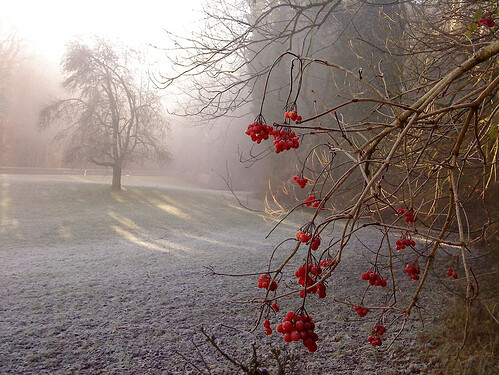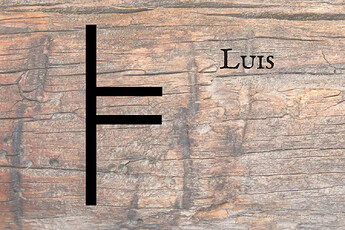Next up on our ogham journey is Lus. Not sure what ogham is? Here is a quick refresh…
Ogham is an ancient Irish inscription alphabet that was used to inscribe headstones and other important markers. In mythology, it was created by the God Ogma (OH-muh) to warn Lugh about a plot to steal his wife. Today, Ogham is used in magic and divination.
If you want to learn more about what ogham is in general, I wrote about that here: Irish Tree Language - The Ogham ![]()
I also have a video explaining the origin story of ogham that you can watch here: https://youtu.be/CWEm2pcAFc8
Lus (loose) is the second fíd in the ogham alphabet. It is associated with two different trees, the elm and the rowan. However, we will focus on rowan for this post. The letter for Lus is written with one vertical line and two horizontal lines on the right side only. There is a picture at the bottom of this post so you can see.
Li sula, delight of eye, that is luis, quicken tree, l, to wit, the flame. The Ogham Tract
The word Lus might derive from two different Irish roots, leuk- meaning “to shine,” or leudh- meaning, “to grow.” We can see both of these word meanings when we look at The Ogham Tract and the words connected there – quicken tree and the flame.
In Irish mythology, The Goddess Brigid is associated with sacred fire and is the patron of smithcraft, poetry, and healing. These are all associated with expressions of the flame - passion, work, and transformation. For me, this gives this fíd a deeper meaning and magic, especially being connected to a goddess I work with closely.
The Rowan Tree
The particular Rowan trees that the Irish people would have encountered when the Ogham were created were the Sorbus aucuparia. This tree has a slender trunk with smooth bark and a loose, roundish crown. It is undemanding and frost hardy, often colonizing disrupted and inaccessible places as a short-lived pioneer species. The Rowan tree has traditionally been used for cooking, as medicine, and as food for livestock. It is tough and flexible, making it an ideal candidate for woodworking. It is also planted to fortify the soil in mountain regions, but it is also planted as an ornamental tree because…well… it’s pretty to look at!
In Irish folklore, it is said that the Rowan is sacred and used in many places around the home.
The rowan was sacred, and used in many forms about the homestead. ‘Failean caorruinn,’ a rowan sucker, or ‘fleasg caorruinn,’ a rowan wand, was placed over the lintels of the barn, byre, stable, sheep-fold, and lamb-cot, as a safeguard against witchcraft and malicious spirits. A twig of rowan was coiled into a circlet and placed beneath the milk boynes to keep the milk from being spirited away. A fire of rowan was sacred, and therefore the festival cakes were cooked with rowan faggots or other sacred wood.
A coffin, or a bier, or the spokes on which it was carried, was treated with especial reverence if made of the mountain ash.
Old Irish
‘A chraobh chaorrainn sin ’s an dorus,
Theid thu fotham-sa dh’an chill,
Cuirear m’ aghaidh ri Dundealgan,
’S deantar dhomh-sa carbad grinn.’
English
Thou rowan tree before the door,
Thou shalt go under me to the burial place,
My face shall be put toward Dundealgan,
And a beautiful bier shall be made for me.
There are some other sources on Wikipedia that say Rowan was believed to ward off evil spirits and witches, used as dowsing rods in England, and even used to drive cattle to pasture for the first time in spring to ensure their health and fertility. I don’t have access to their sources, though, so I can’t verify the accuracy of that information.
In Divination
Again, let’s look at how Rowan behaves and what it is traditionally used for. It is flexible yet sturdy. It is used in cooking but also in the wheels that carry caskets to the grave. It has traditionally been used as a protective amulet or wood, keeping livestock and people safe from malicious spirits or other harm. It is also important to remember the flame as an aspect of Lus, being connected to Brigid and the sacred fire. This brings with it the meaning of inspiration.
If you are reading Ogham staves and Lus makes an appearance, it might be a sign to you that inspiration is getting ready to strike. You may also need to open yourself up to this inspiration or seek help from those around you. Keep your witch eyes open, so to speak, and watch for signs and omens from your Gods and spirits. It may also be a sign to you to do some cleansing and warding of your space, leaning into the protective nature of Lus.
Here are some keywords I’ve come up with in my studies for Lus in regard to divination.
- inspiration
- passion
- creativity
- protection
- sustenance
- healing with herbs
- hearth fire
- spiritual teachers
With Lus being connected to the flame of inspiration, it is another ogham fíd that holds a special place for me. I have yet to do it, but I can see myself carving this fíd into a candle for a bit of extra inspiration when I need it.
Sources and Further Reading
– Celtic Ogham Symbols and Their Meanings
– The Ogham Tract
– Weaving Word Wisdom by Erynn Rowan Laurie

